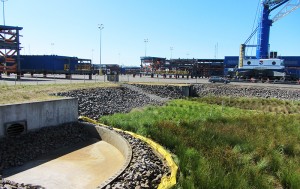Success at Biofiltration Facility
 In 2009, the port funded construction of one of the largest stormwater biofiltration facilities in the world. Port staff needed a system to treat runoff from 50 acres at Terminal 2, and designed a one-of-a-kind facility that is able to treat runoff at a rate of 18 cubic feet per second. Filtration removes traces of metals and oils that are often found at industrial facilities.
In 2009, the port funded construction of one of the largest stormwater biofiltration facilities in the world. Port staff needed a system to treat runoff from 50 acres at Terminal 2, and designed a one-of-a-kind facility that is able to treat runoff at a rate of 18 cubic feet per second. Filtration removes traces of metals and oils that are often found at industrial facilities.
Stormwater runoff from the terminal first enters the biofiltration facility through two inlet pipes for preliminary metals removal through ion absorption and filtration. An inlet bay with an oil boom then collects runoff and provides preliminary sediment removal and oil reduction. Stormwater then infiltrates through an amended compost/sand mixture before the under-drain piping discharges the treated runoff to the Columbia River. Water quality data collected between 2010-2013 has shown vastly improved removal of copper, zinc and turbidity.
Permitting through Washington state’s Department of Ecology requires quarterly testing of water discharged to the Columbia River. The port recently demonstrated eight consecutive quarters of meeting or exceeding Department of Ecology benchmarks for all parameters of water quality under its Industrial Stormwater General Permit. This means the port can cease testing (for parameters other than oil sheen) for the remainder of the annual permit cycle (12 months). Because of the system’s success in treating stormwater, the port installed a similar system at its Centennial Industrial Park and the system is a model for other biofiltration facilities being designed for other northwest properties.
